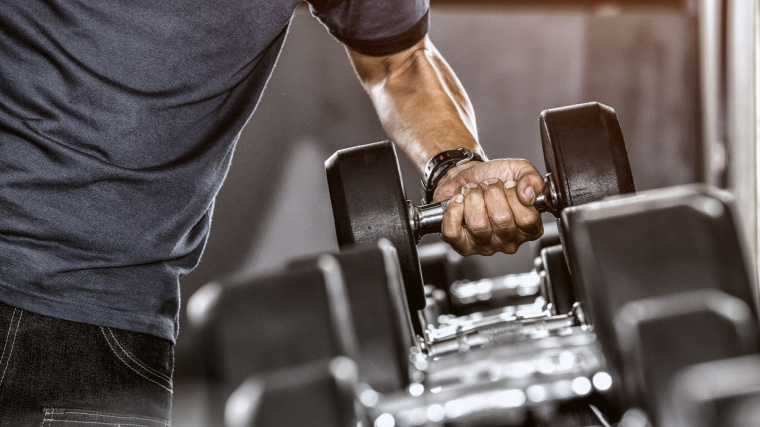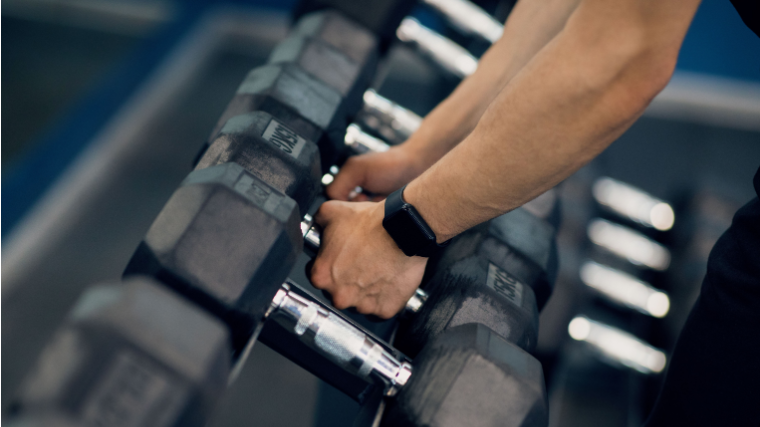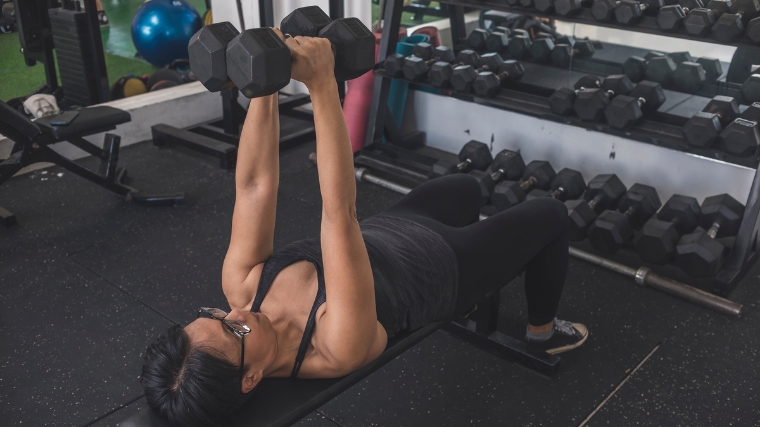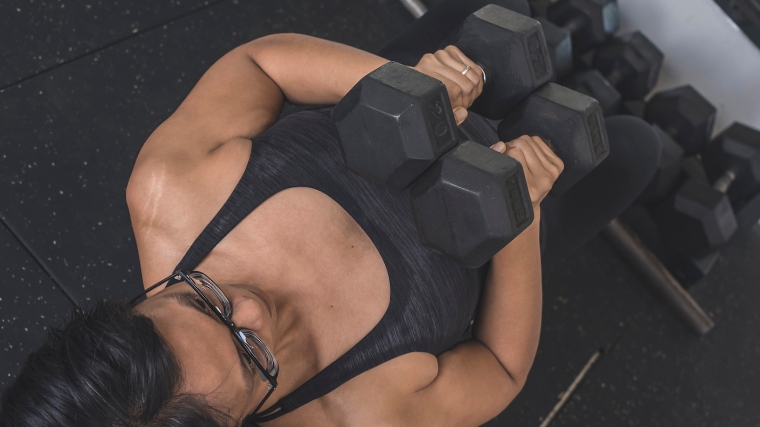[ad_1]
If you train your chest seriously, you’ve probably done plenty of barbell bench pressing. And dumbbell pressing. Oh, and you can’t forget the incline press for those upper pecs, of course. And then there’s the decline press for the lower chest. In fact, you’ve probably done more chest pressing than you’d care to admit. Maybe it’s time to put a new spin on things.
The best chest exercise should take your pecs through their full contractile range of motion while also engaging your shoulders and triceps. Most presses accomplish this just fine, but you can’t always feel your chest working in the process.

The hex press gets you there. This movement incorporates some isometric training and really elevates your pressing game by not only pressing with your chest but squeezing the muscle together in the process. The result is a world-class pump and some upper-body gains to boot. Here’s how to do it.
How to Do the Hex Press
If you typically perform dumbbell chest presses in your workout, you have everything you need to master the hex press. However, do take note that the type of dumbbells you use may impact your performance.
Cylindrical dumbbells might make the exercise more difficult to perform. If you have hexagonal dumbbells — hence, hex press — you’re good to go.
Step 1 — Grab Some Dumbbells

Grab a moderate-to-heavy pair of dumbbells and sit on the end of a weight bench. In one swift but controlled motion, kick off the floor with your feet and rock backward. Straighten your arms as you lie down on the bench and firmly plant your feet.
Coach’s Tip: “Kicking” yourself into position for a dumbbell press takes a bit of finesse to learn. Make sure you brace your core.
Step 2 — Hold the Weights Together

Brace your core and hold the dumbbells together at arm’s length above your shoulders. This is the most important bit; your palms should face one another and the sides of each dumbbell should make direct contact with one another.
Coach’s Tip: Actively push the dumbbells together as if you were trying to fuse them into one weight.
Step 3 — Lower and Press

With the sides of the dumbbells firmly pressed together, lower the weights down toward your abdomen. Once the weights make contact with your chest, press them back to the starting position. Keep them in contact with one another the entire time.
Coach’s Tip: Keep your arms tucked tightly to your sides as you lower the weights during the hex press.
Hex Press Sets and Reps
When it comes to programming, the hex press fits nicely into any set-rep scheme you’d typically use for your regular dumbbell presses. If you need a refresher, here are a couple of different ways you can go about implementing hex press sets and reps:
- For Beginners: Keep it simple with 3 sets of 10 reps and a moderate weight.
- For Muscle Growth: Try 4 sets of 8 reps, pushing close to muscular failure.
- For Strength: Try 5 sets of 6 reps with a heavy weight and ample rest.
Common Hex Press Mistakes
It may not be as complicated as an exercise like the snatch — or even a standard barbell bench press — but there’s still plenty that can go wrong during the hex press. Keep these technical elements in mind before you start banging out sets of hex presses.
Not Maintaining Contact
The defining feature of the hex press is that the dumbbells remain firmly pressed together for the duration of the set. If you can’t maintain this contact, you’re essentially performing a simple neutral-grip dumbbell press. So, no matter what, ensure that when you perform the hex press, the weights you’re holding remain firmly in contact with each other.
Not Touching Your Chest
Take away the unique setup and execution and you’re left with a chest press like any other, which means you should probably be using a full range of motion. While the exact point of contact for the hex press will differ from other pressing motions, barring an injury or physical limitation, you should make an effort to touch the weights to your chest on every rep.
Elbows Flaring
To hold the dumbbells together during the hex press necessitates a nice tucked arm position. You need neutral wrists to properly perform the hex press, which means externally rotating your shoulder and dropping the weights low on your chest.
If your elbows are flaring out, there’s a good chance that you aren’t keeping the sides of the dumbbells in contact with each other, thus defeating the purpose of the movement.
Hex Press Variations
There are far more customizable exercise options out there than the hex press. That said, you can still put a twist or two on the movement to introduce some variety. Try out these variations if you’re curious:
Incline Hex Press
The incline hex press is a solid option if you want to emphasize your upper chest. Place an adjustable bench at a low incline (think anywhere from 15 to 30 degrees) and perform the movement as you normally would.
The inclined surface provides more range of motion at your shoulder, which should emphasize your upper pecs. Note, though, that working from an incline will likely reduce the amount of weight you can use during the hex press.
Cable Hex Press
Unsurprisingly, a cable station will enhance your experience with the hex press. Constant muscular tension and an adjustable station make for a solid recipe for muscle growth.
Note, though, that this exercise may feel awkward if the two cable attachments are too far apart. The further apart each fixture is, the further you’ll have to walk out with the cables in-hand. Still, it’s a great option for keeping constant tension on your pecs.
Hex Press Alternatives
If you can’t get the hex press down pat but still enjoy the exercise on paper, you’re in luck. These hex press alternatives provide similar benefits to the movement in question but are different enough to be stimulating and fun on their own merit.
Diamond Push-Up
Bodyweight exercises aren’t just for beginners. With the right modifications, even the humble push-up can become quite challenging. To mimic the demands of the hex press with just your own body weight, try the diamond push-up instead.
This movement places your arms in a similar position as you’d find during the hex press. You can even slap a weight plate on your back for some extra resistance if necessary, but you might find that the diamond push-up is plenty challenging on its own.
Cable Chest Press
Cables are a bodybuilder’s best friend, and for good reason. They provide consistent mechanical tension to the muscle or muscles you’re trying to work and come with nearly infinite customization options.
A good cable chest press will stimulate the two primary functions of the pecs: Pushing your arm forward in space and drawing your arm inward toward your midline. It may be difficult to set up in a busy gym, but the cable chest press is a fantastic substitute for the hex press if you can make it work.
Close-Grip Bench Press
To ante up on the mechanical tension and strength-building potential, swap out the hex press and work with the barbell instead. The close-grip bench press will torch your chest, sure, but it also works your triceps and anterior deltoids.
More specifically, your bar path during the close-grip bench press should be nearly identical to how you’d move your dumbbells during the hex press. You should therefore experience some decent carryover between the two exercises.
Muscles Worked by the Hex Press
Understanding how your body interacts with the exercises you perform can elevate your results. You can optimize your technique and apply more effort on a set-by-set basis if you know the “how” and the “why” behind the movements in your workout. Here’s how your body works during the hex press.
Pectorals
The pectoralis major attaches from your sternum to your upper arm bone and has two distinct heads; sternocostal and clavicular. Your pecs primarily draw your arm laterally toward your midline. This motion comes into play during both presses and flye exercises. You’ll find your chest doing most of the work during the bottom half of the hex press.
Upper Pecs
The pec minor is a deep tissue that sits under your pecs proper and actually attaches to your shoulder blade. This is the muscle that most people strive to train when they want to stimulate their “upper chests.”

Due to its anatomical insertion, you can engage your pec minor by choosing chest exercises that involve more shoulder flexion. The hex press is a phenomenal selection here, especially if you perform it on an inclined surface.
Triceps
Your triceps sit on the back of your upper arm, but they actually attach all the way from your shoulder blade down onto your forearm. During the hex press, your triceps stabilize your elbow joint as you lower the weights. They’re the primary extensor in play during the top half of the repetition as you return the dumbbells to the starting position.
Deltoids
Any chest press exercise you perform will involve the musculature in your shoulders to some degree. Your anterior deltoids, which are one of three sections of the deltoid musculature, assist your pecs throughout the entire range of motion of the hex press. Don’t expect much muscular engagement in the lateral or rear deltoids during horizontal presses, though.
Benefits of the Hex Press
It won’t solve all your chest gain woes in one fell swoop, but the hex press isn’t without its own perk package. In fact, the benefits available to you go way beyond novelty. Here’s what you stand to gain from getting into the hex press.
Easy to Perform
Logistics are front-of-mind when it comes to designing a good workout program. You can have the most well-crafted, meticulously designed routine in the world, but if you can’t get into the gym and complete it in the first place, you’re out of luck.
The hex press gains points for convenience. All you need is an available bench and a pair of dumbbells — both of which you should be able to get ahold of, even in a busy gym. The technique is also relatively straightforward and easy to learn. One practice session should have you up and running.
Introduces Variation
Variety is the spice of life. In the weight room, switching things up can help you stay mentally engaged with your workouts, sweetening the results you ultimately earn. The hex press is distinct enough from other chest presses to be productive, but similar enough that you won’t feel like you’re straying into uncharted territory.
A Great Mind-Muscle Connection
If you struggle to really feel your pecs working on International Chest Day, you need to know a few things. First, the mind-muscle connection is a real phenomenon and does impact your gains on some level. However, research isn’t conclusive about whether it truly impacts muscle growth long-term. (1)
That said, if you can feel the target muscle working, you’ll probably be more motivated to train. The setup of the hex press really encourages actively contracting your pecs from start to finish by forcing you to press the weights against one another.
Who Should Do the Hex Press
If you want to build muscle, you should do the hex press. If you’re bored of your standard dumbbell pressing, you can give the hex press a go. For these and many more reasons, you’re probably in the right place.
If You Only Have Light Weights
You don’t need access to ultra-heavy weights to build and train your chest — though they certainly help. Making the most out of a light-weight workout is all about selecting exercises that compromise your leverage.
The setup and execution of the hex press is appropriate here; you may not be able to press as much as you can on a standard dumbbell press, but it’ll still be quite challenging for your pecs. Go for the hex press and bang out some high-rep sets if you don’t have heavier dumbbells to work with.
Bodybuilders or Those With Physique Goals
If you want to put on muscle, you should utilize a wide variety of movements. The standard bench press is all well and good, but you should consider swapping in the hex press to diversify your chest training.
In addition to the novelty, the hex press may also allow you to continue training your upper body without accumulating as much wear and tear on your shoulder, elbow, or wrist joints, since you can’t lift as heavily to begin with.
A Fresh Press
The hex press flies under the radar of chest exercises. If you’ve never plugged it into your workouts before, you’re definitely missing out. Holding two dumbbells against each other while you press not only increases the stability demands of the movement, but substantially increases the challenge on your pecs. Try it for yourself and you’ll see the juice is worth the squeeze.
FAQs
Not sure about the hex press? No biggie. Check out these common questions to put your fears to rest.
Why is it called a hex press?
The exercise’s name comes from the type of equipment you want to use. If you have hexagonal dumbbells, you’re in business for the hex press, since the edges of the weights collapse flatly against each other.
Cylindrical dumbbells work just fine, though they’re harder to control since they’re liable to roll past each other as you press.
Do I need hexagonal dumbbells to do the hex press?
No! As long as you can comfortably push a pair of dumbbells into each other, you’re good to go with the hex press. Hexagonally-shaped dumbbells are just the easiest and most convenient option.
References
- Schoenfeld, B. J., Vigotsky, A., Contreras, B., Golden, S., Alto, A., Larson, R., Winkelman, N., & Paoli, A. (2018). Differential effects of attentional focus strategies during long-term resistance training. European journal of sport science, 18(5), 705–712.
Featured Image: MDV Edwards / Shutterstock
[ad_2]
Source link
Fitnessnacks – #HexPress #NextLevel #Chest #Gains
Courtesy : https://barbend.com/hex-press/
